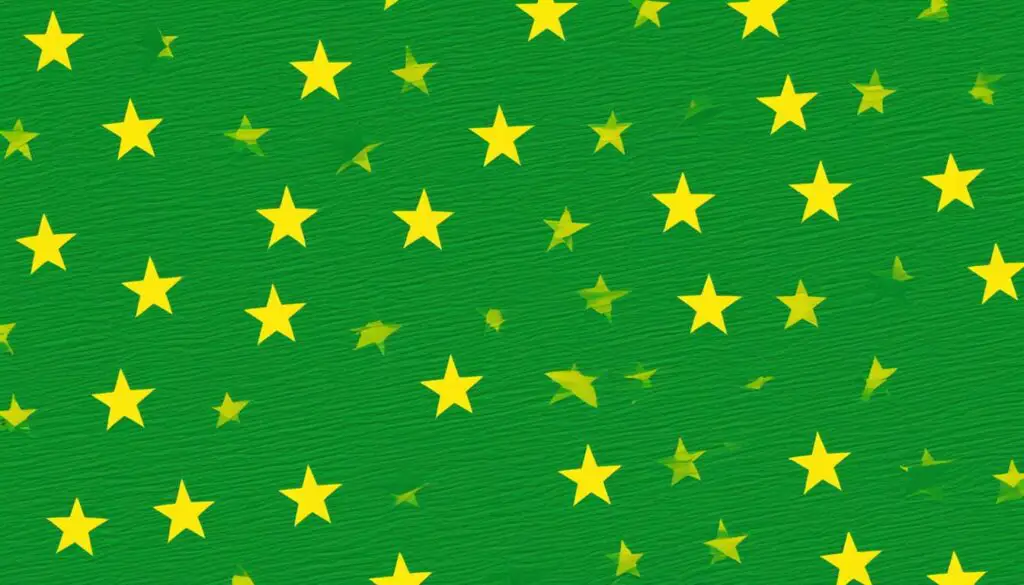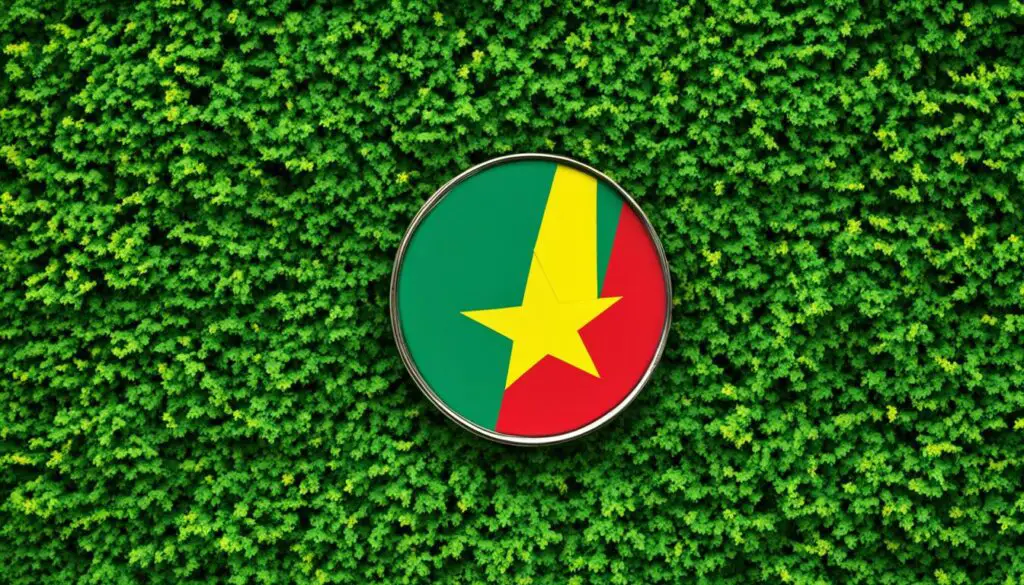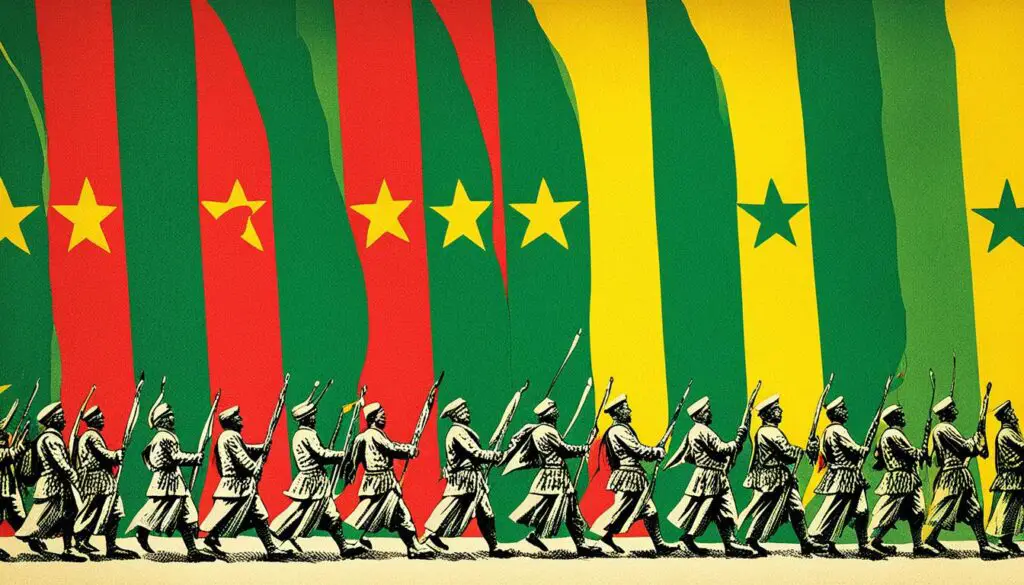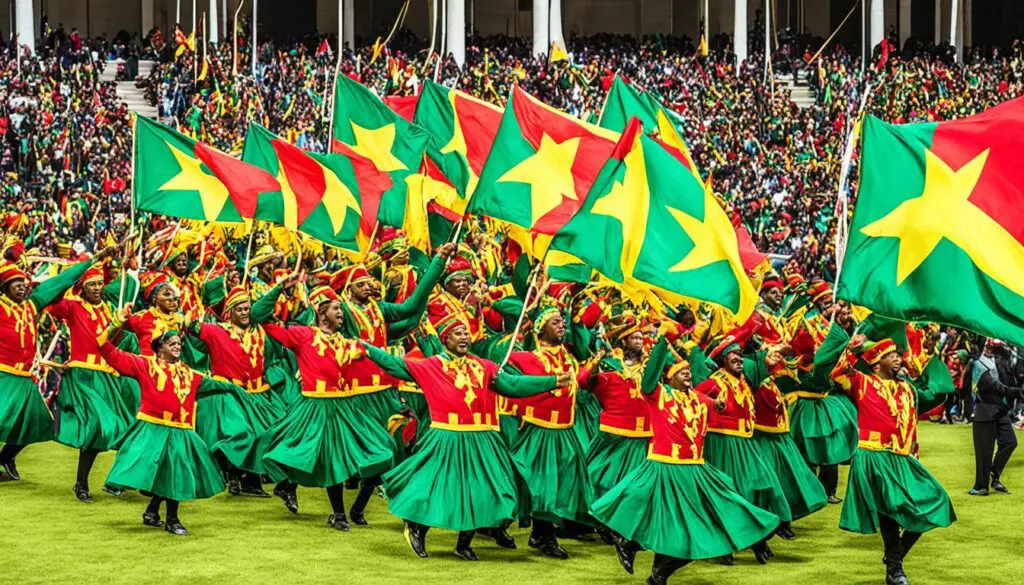In this section of our article, we will delve into the symbolism and significance behind the flag of Cameroon. The flag serves as a powerful representation of a nation’s identity and heritage. By exploring the history and cultural context of the Cameroon flag, we can gain a deeper understanding of its meaning and the values it embodies.
Key Takeaways:
- The flag of Cameroon holds deep cultural and historical significance for the country.
- Understanding the meaning behind the flag helps to appreciate its symbolism and representational value.
- The colors, design, and emblem of the flag each carry specific meanings and messages.
- The Cameroon flag is a symbol of unity and diversity, representing the coming together of different ethnic groups.
- Respecting the flag and its proper display is an essential part of honoring national pride and identity.
The Design of the Cameroon Flag
When examining the design of the Cameroon flag, we discover a rich tapestry of elements that represent the vibrant nation. The flag’s composition incorporates various colors, shapes, and patterns, each holding significance as a visual representation of Cameroon’s identity.
Let’s delve into the design details of the flag:
The Colors
At first glance, the vibrant colors of the Cameroon flag catch the eye. The flag features three vertical stripes: green, red, and yellow. Each color plays a vital role in reflecting Cameroon’s natural beauty, resilience, and cultural heritage.
The Shapes and Patterns
The flag’s simple yet impactful design showcases the harmonious combination of shapes and patterns. The green stripe signifies hope, fertility, and the lush vegetation of the country. The red stripe represents the country’s independence, unity, and the sacrifices made by its people. Finally, the yellow stripe symbolizes the country’s natural resources, sunlight, and progress.

The symbolism behind the design of the Cameroon flag is a testament to the nation’s pride and cultural heritage. It serves as a visual representation of the country’s history, values, and aspirations.
The Colors of the Flag
When examining the flag of Cameroon, it is essential to understand the meaning behind its vibrant colors. Each color holds symbolic significance, reflecting the country’s identity and values.
The flag features three vertical stripes of equal width. The dominant shade is green, symbolizing hope for a prosperous future. The green stripe represents Cameroon’s lush vegetation and agricultural wealth, highlighting the nation’s commitment to growth and sustainability.
The red stripe, situated between two yellow stripes, signifies strength, unity, and resilience. Red represents the country’s struggle for independence and the sacrifices made by its people. It serves as a reminder of the determination to overcome challenges and achieve national unity.
The yellow stripes represent the country’s rich cultural diversity. They symbolize the sun and the bright future that awaits Cameroon. Yellow also signifies happiness, optimism, and the country’s desire for prosperity and development.

Together, these colors create a vibrant and harmonious flag that embodies the spirit and aspirations of the Cameroonian people. They represent the nation’s natural beauty, resilience, unity, and pursuit of a prosperous future.
The Central Emblem
At the heart of the Cameroon flag lies a powerful emblem that holds deep historical and cultural significance. This emblem is a key element that distinguishes the flag and represents the unique identity of the country.
The central emblem featured on the Cameroon flag consists of a five-pointed star encircled by a green-red-yellow stripe pattern. The star symbolizes the unity of the French and English-speaking regions of Cameroon. It also represents the guiding light and aspirations of the nation as it moves toward progress and development.
The green stripe, located at the top of the emblem, represents hope and the agricultural wealth of the country. It symbolizes the lush forests, fertile lands, and abundant natural resources that sustain the people of Cameroon. The red stripe, in the middle, signifies the courage, strength, and determination of the Cameroonian people. It represents their fight for independence and their commitment to unity and progress.
The yellow stripe, at the bottom of the emblem, represents the sun. It stands for the bright future of the nation, filled with optimism and prosperity. The yellow color also reflects the rich cultural heritage and diversity of Cameroon, with over 200 ethnic groups harmoniously coexisting within its borders.
Historical and Cultural References
The central emblem draws inspiration from various historical and cultural references that are deeply rooted in Cameroon’s past. The five-pointed star, for instance, harkens back to the struggle for independence and the desire for unity among the diverse regions of the country.
The green-red-yellow stripe pattern is reminiscent of the Pan-African colors, which symbolize the aspirations of African nations for unity and freedom. This design choice reflects Cameroon’s commitment to Pan-African ideals and its role in the larger African community.
The emblem also pays homage to the historical significance of the Cameroonian people. It represents their resilience, unity, and a shared vision for a better future. The central emblem on the Cameroon flag serves as a powerful symbol of national pride and identity, encapsulating the spirit of the nation.
 }}
}}
Historical Evolution of the Flag
Over the course of history, the Cameroon flag has undergone significant changes, reflecting the country’s journey and evolution. Understanding the historical evolution of the flag provides valuable insight into its design and symbolism.
The first version of the flag was adopted in 1957 when Cameroon was still a British-administered territory. It featured a green background with a centered gold star and a gold stripe at the top. This design represented the aspirations for independence and unity.
After achieving independence in 1960, Cameroon went through a period of political transitions and ideological changes, which led to modifications in the flag’s design. In 1961, the flag was updated to include two vertical stripes of green and red, representing the unification of British Cameroon and French Cameroon.
During the 1970s, Cameroon embraced a more socialist ideology, which influenced the flag’s symbolism. The green stripe came to symbolize hope for future development and prosperity, while the red stripe represented the struggle for independence and the sacrifices made by the nation.
It wasn’t until 1984 that the current design of the Cameroon flag was established. The flag consisted of three vertical stripes: green, red, and yellow, from left to right. The yellow stripe in the middle symbolizes unity, reflecting the diverse ethnic groups within the country. This design has remained unchanged since then.

The historical evolution of the Cameroon flag showcases the country’s journey towards independence, unity, and national identity. It represents the aspirations, struggles, and achievements of the Cameroonian people throughout history.
Cultural Significance of the Flag
The Cameroon flag holds great cultural significance for the people of Cameroon. It is not only a symbol of national pride but also represents the rich history and diverse cultural heritage of the country.
Embraced and celebrated by the people, the Cameroon flag serves as a powerful reminder of unity and the spirit of togetherness. It represents the coming together of different ethnic groups that make up the vibrant tapestry of Cameroonian society.
In various contexts, such as national celebrations, cultural events, and sporting competitions, the Cameroon flag takes center stage as a symbol of identity and solidarity. It is proudly displayed and waved by individuals, communities, and organizations to showcase their deep-rooted love and appreciation for their country.
The flag serves as a unifying force that brings together people from all walks of life. It symbolizes the shared values, aspirations, and dreams of the Cameroonian people, and serves as a source of inspiration and motivation.

Whether it’s during independence day celebrations, cultural festivals, or international sporting events, the Cameroon flag is a constant presence, evoking a sense of national pride and patriotism. It stands as a testament to the resilience, strength, and unity of the Cameroonian people.
The cultural significance of the Cameroon flag extends beyond its physical representation. It embodies the collective memory, struggles, and triumphs of the nation, reminding its citizens of their shared history and the importance of preserving their cultural heritage.
The Cameroon flag is more than just a piece of fabric; it is a cherished symbol that instills a sense of belonging, unity, and pride in the hearts of the Cameroonian people.
The Flag in National Events
During national events and celebrations in Cameroon, the flag plays a central role in symbolizing the country’s pride and unity. It is prominently displayed in various settings, creating a sense of national identity and commemoration.
The Cameroon flag is often seen fluttering proudly during important occasions such as Independence Day, National Day, and sporting events. It serves as a visual representation of the nation’s history, culture, and aspirations.
For instance, during Independence Day celebrations, the flag takes center stage as a powerful symbol of freedom and self-determination. It is raised high above government buildings, schools, and public spaces, evoking a sense of national pride and unity among the people.
Furthermore, during sporting events, the Cameroon flag is proudly worn by athletes as they represent their country on international stages. It serves as a reminder of the collective support and encouragement from fellow citizens, motivating the athletes to perform at their best.
Whether it’s a political rally, a cultural festival, or a momentous national event, the Cameroon flag is present, reminding citizens of their shared values and common goals. It fosters a sense of belonging and solidarity, promoting national cohesion.
The Flag as a Symbol of Unity
In addition to its representation in national events, the Cameroon flag is a powerful symbol of unity. It brings together the diverse population of the country, transcending ethnic, linguistic, and regional differences.
The flag’s design, colors, and emblem reflect Cameroon’s commitment to inclusivity and diversity. It serves as a reminder that, despite the country’s various ethnic groups, its citizens are united under one national identity. The flag promotes a sense of togetherness and encourages mutual respect and understanding among Cameroonians.
As Cameroon continues to evolve and embrace its rich cultural heritage, the flag remains a steady symbol of unity, reminding the nation of its shared past, present, and future.
The Flag as a Symbol of Unity
The flag of Cameroon holds a significant meaning beyond its design and colors. It serves as a powerful symbol of unity for the diverse population of the country.
Cameroon is a nation with over 200 different ethnic groups, each with its own culture and traditions. The flag brings these groups together, representing the collective strength and harmonious coexistence of the Cameroonian people.
The three vertical stripes of green, red, and yellow represent the different regions of the country: the north, south, and west respectively. These colors serve as a visual reminder that irrespective of individual backgrounds, the people of Cameroon are bound together as one nation.
By embracing the flag, Cameroonians demonstrate their commitment to unity and celebrate the diversity that enriches their nation. It serves as a unifying symbol, reminding citizens of their shared values, history, and aspirations.
The flag of Cameroon is proudly displayed during national events, celebrations, and sporting competitions. It is a rallying point that brings people together and instills a sense of pride, fostering a collective identity that transcends ethnic boundaries.
As Cameroon continues to progress and embrace its multicultural society, the flag remains a powerful emblem that promotes unity, understanding, and respect among its citizens.
Respect for the Flag
Understanding the importance of respecting the Cameroon flag and adhering to the etiquette associated with its display and handling is essential. By honoring and treating the flag with reverence, we pay tribute to the nation it represents and the values it embodies.
The flag of Cameroon holds great significance as a symbol of national identity and pride. It is a visual representation of the country’s history, culture, and unity. As we display and handle the flag, we must do so with the utmost respect and care.
When displaying the flag, it should always be hoisted and lowered with dignity. It should be placed in a prominent location where it can be seen and appreciated. The flag should never touch the ground, and it should be protected from damage or defacement.
During events where the national flag is being showcased, such as parades or ceremonies, observers are expected to stand in respect. It is customary to remove any headwear and place the right hand over the heart, showing honor and allegiance.
Flag Etiquette
It is important to familiarize ourselves with the protocols and customs surrounding the Cameroon flag to properly show our respect:
- Flag Handling: The flag should be treated with clean hands and should never be used for any undignified purposes.
- Flag Placement: When displaying the flag indoors, it should be hung to the right, while other flags or banners should be placed to the left. Outdoors, the flag should fly above any other flags in the vicinity.
- Nighttime Display: If the flag is displayed overnight, it should be properly illuminated.
- Half-Staff Flying: Flying the flag at half-staff signifies a period of mourning. It is important to understand the reasons and occasions for lowering the flag in this manner.
- Flag Retirement: When the flag becomes worn, torn, or faded, it should be retired in a respectful manner. This may involve burying, burning, or otherwise disposing of the flag with dignity.
By upholding the customs and protocols surrounding the Cameroon flag, we demonstrate our respect for the nation and its people. Together, let us honor this symbol of unity, strength, and heritage as we celebrate the rich history and culture of Cameroon.
Flags of Similar Design
While the flag of Cameroon holds a unique design and symbolism, there are other flags from around the world that share similarities with it. These flags exhibit commonalities either in their color scheme, patterns, or emblematic representations. Exploring the connections between these flags can provide us with a deeper understanding of the shared cultural and historical influences.
One flag that bears resemblance to the Cameroon flag is the flag of Chad. Both flags feature similar colors, with vertical stripes of green, yellow, and red. However, the Chad flag incorporates a blue disc in the center, representing the sky and water resources.
Another flag that shares similarities is the flag of Mali. Like the Cameroon flag, the Malian flag employs vertical stripes of green, yellow, and red. However, the Mali flag features an emblem of a golden star in the center, symbolizing unity and progress.
Take a closer look at these flags and explore their nuanced differences, as well as their notable connections to the flag of Cameroon:
Flag of Chad
The flag of Chad consists of three vertical stripes of blue, yellow, and red. The blue stripe represents the sky and hope, the yellow stripe symbolizes the sun and the desert, and the red stripe represents unity and progress. The emblem in the center of the flag consists of a golden five-pointed star, representing the unity of the Saharan peoples.
Flag of Mali
The flag of Mali features three vertical stripes of green, yellow, and red. The green stripe represents fertility and the agricultural wealth of the country, the yellow stripe represents the sun and the desert, and the red stripe symbolizes the bloodshed by those who fought for independence. In the center of the flag is an emblem of a golden five-pointed star, symbolizing unity, progress, and the African continent.
By exploring flags with similar designs, we gain a broader perspective on the cultural and historical influences that shape national symbols. These connections serve to deepen our appreciation for the symbolism embedded within the flag of Cameroon and further highlight its unique significance.
Conclusion
In conclusion, the flag of Cameroon holds deep symbolism and significance that reflects the country’s history, culture, and unity. Understanding the meaning behind this national symbol is essential to appreciating its true value.
Through its design, the Cameroon flag represents the nation’s aspirations and identity. The colors of green, red, and yellow symbolize hope, unity, and sovereignty, while the central emblem showcases the country’s rich cultural heritage.
Not only is the flag an important emblem, but it also plays a vital role in national events and celebrations, acting as a powerful symbol of pride for the people of Cameroon. Additionally, it serves as a unifying force, bringing together diverse ethnic groups and fostering a sense of national unity.
Respecting the Cameroon flag is crucial, and proper etiquette should be observed when displaying and handling it. This respect extends to the understanding of the flag’s history, cultural significance, and the protocols associated with its use.
FAQ
What is the meaning behind the Cameroon flag?
The flag of Cameroon holds significant symbolism representing the unity, diversity, and history of the nation.
How is the design of the Cameroon flag structured?
The Cameroon flag consists of three vertical bands of green, red, and yellow, with a gold star in the center.
What do the colors of the Cameroon flag represent?
Green represents hope and fertility, red symbolizes unity and strength, yellow signifies the sun and happiness, while the gold star represents unity and sovereignty.
What is the significance of the central emblem on the Cameroon flag?
The central emblem on the Cameroon flag represents the unity of the nation and its cultural heritage.
How has the Cameroon flag evolved throughout history?
Over the years, the Cameroon flag has undergone several changes in design, reflecting shifts in the country’s political and cultural landscape.
How is the Cameroon flag celebrated within the country?
The Cameroon flag is embraced and celebrated by the people of Cameroon during national events, sports tournaments, and cultural festivals.
What role does the Cameroon flag play in national events?
The Cameroon flag is prominently displayed and used during national events and celebrations, symbolizing national pride and unity.
How does the Cameroon flag represent unity?
The Cameroon flag serves as a symbol of unity, reflecting the coming together of different ethnic groups and fostering a sense of national identity.
What is the importance of respecting the Cameroon flag?
It is important to show respect to the Cameroon flag by following proper etiquette in its display, handling, and during national ceremonies.
Are there any other flags similar to the design of the Cameroon flag?
While unique in its design, the Cameroon flag shares some similarities in color symbolism with flags of other African nations, such as Benin and Guinea.